KNIT MAGAZINE
What is knit sharpening? | Techniques that can express the uniqueness of knits

- Post date:
- June 3, 2020 07:00
KNIT MAGAZINE


We translate with Google Translate. You can contact us if you have any question.
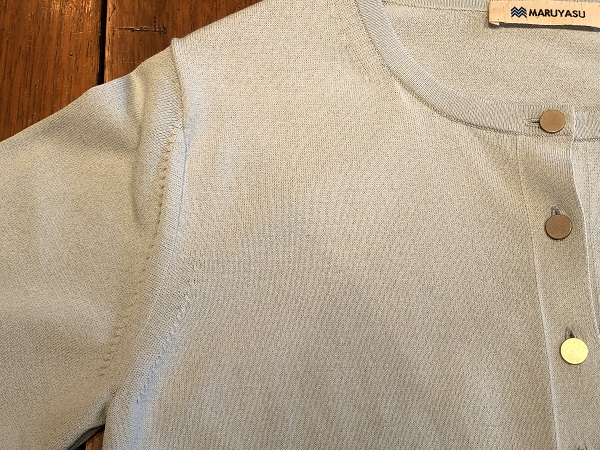
Hello, this is Akaishi.
This time, I would like to explain the “sharpening” of knitwear.
Table of Contents
It is a stitch that is made when increasing or decreasing the molding.
By straightening the edges (through the eyes), you can clean the rattling of the seams and the rattling of the seam allowance, and the characteristic finish makes it possible to express the knit-likeness.
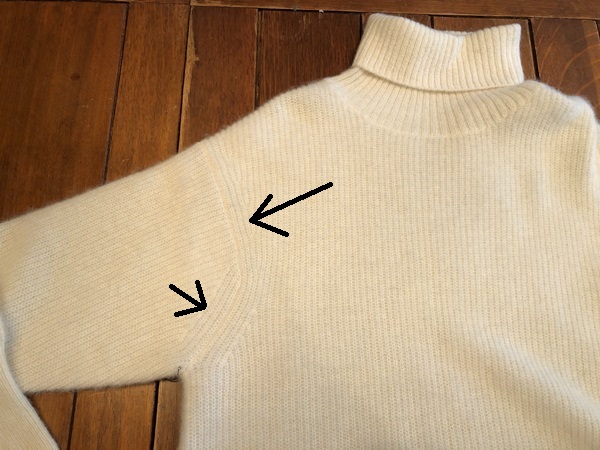
Where the arrow in the photo points, can you see that the line of the stitches is different from the surroundings and goes straight?
This is the state that stands out.
What is the effect of sharpening?
By sharpening, the parts can be connected straight to each other, which has the effect of making it look beautiful as a whole.
Molding is like a photo by knitting according to the shape of the pattern as shown below.
You can see that there is a difference in the finish of the edges of the knitted fabric between the sharpened part and the unsharpened part (edge reduction).

Linking to sew a knit is done by piercing the needle with each stitch, so if the stitches are straight, the seam allowance can be easily taken with a certain width, and the result can be straight and beautiful.
It is also a design that expresses “knit-likeness”.
The same is true for molded sleeves and collars, and it is often used more design-wise.

You’ve seen this kind of pattern.
It has a great impact as a knitted fabric design and is effective when used for low gauge ridge knitting.
I would like to introduce a concrete example of sharpening.
Tianzhu sharpening

The sharpening is at the arrow. ↓
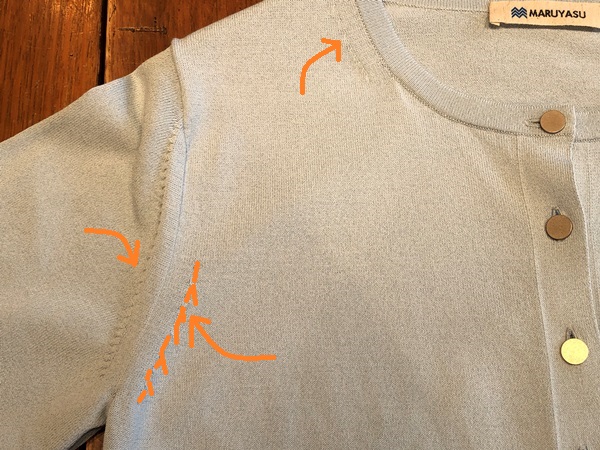
Since the sleeves and collar of the body are molded, the reduced part is conspicuous. (It is called internal reduction)
If you don’t make a sharpening with this Tianzhu, the joint line between the sleeve and the body will be easy to rattle, and it will be difficult for the factory to link, so it is natural to put it in.
The width of the sharpening varies from thin to thick, but my personal impression is that the thicker one is more casual and younger.
Rib sharpening
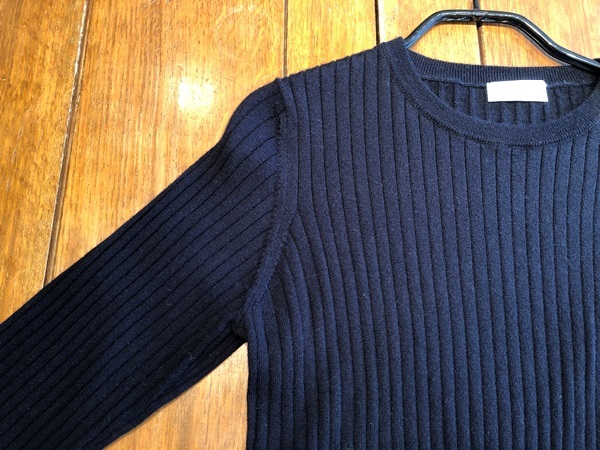
In the case of rib sharpening, if you sharpen it according to the width of the rib, the knitted fabric will be well-balanced and beautiful. Therefore, when instructing, I think it is better to write rib ○ as a sharpening.
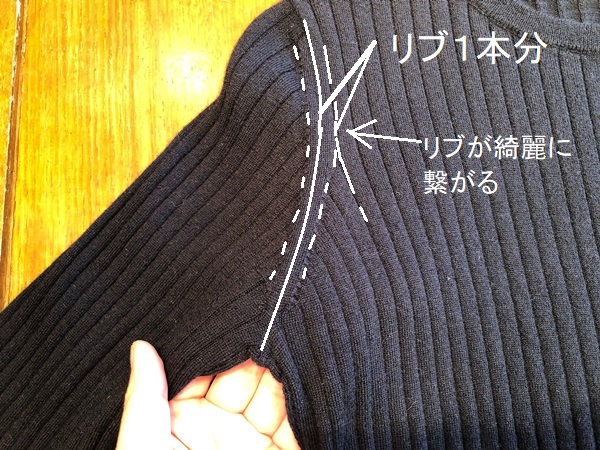
Ridge knitting
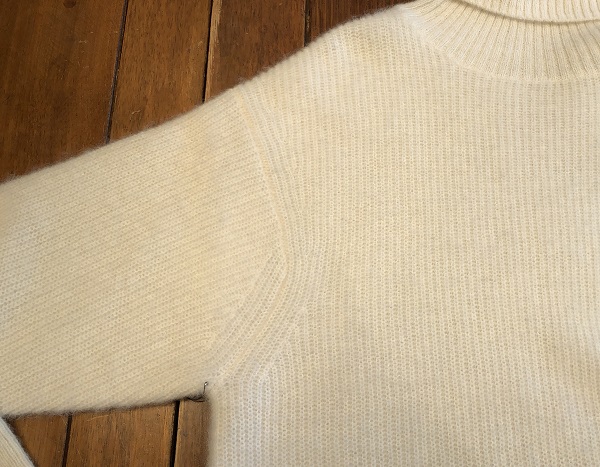
The ridges are made of knitted fabric with three-dimensional texture and a solid pattern, making it easy to make the sharpening stand out.
Since the design can be emphasized more, it is recommended to put a thicker sharpening width.
Sharpening the back shoulders

In most cases, the back shoulders are also sharpened.
Shoulder reduction is also done by turning back or reducing depending on the angle, but since the edges will rattle, sharpening will give a beautiful finish.
others
Organizations such as full needle rubber and Milan ribs may not be machine-friendly / time consuming and impractical.
In the case of full needles and Milan ribs, all the needles of the knitting machine are threaded, so it is necessary to sharpen while moving the threads little by little, and you have to move the machine many times to knit one course.
However, it is difficult to convey in sentences, so it is okay if you think that it will take a long time.
And, if it takes time, the processing cost will be high, so it may be necessary to make a judgment.
Total needle, no sharpening ↓

Since the eyes are clogged, the finish is neat and clean even without sharpening.
When instructing, write a fashion mark on the picture pattern and add a sharpening instruction.
Like this
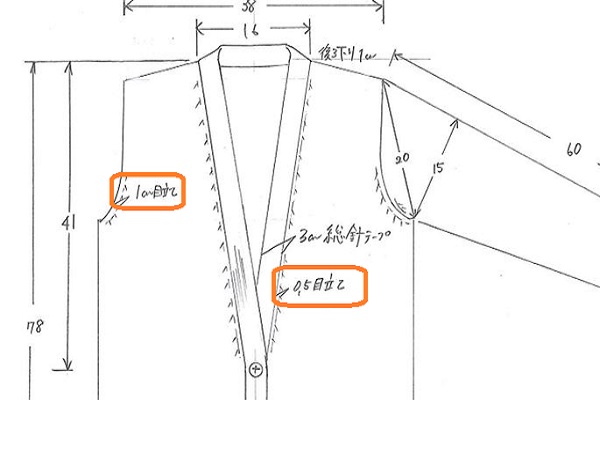
There are two main patterns for writing instructions.
One is when specifying the number of stitches.
Mainly in the case of low gauge, it is often written as [2 sharpening] or [3 sharpening].
The second is when specifying the width.
Mainly in the case of high gauge, it is often written as [0 cm sharpening].
I think that it is easier to convey the design image.
If you cannot sharpen
Some knitted fabrics cannot be systematically sharpened.
Bonding, smooth knitting, etc. I would like you to remember that it is due to the characteristics of the organization.
The impression changes even with a width such as a thin or thick sharpening, so I think that a simple design will be better if you devise a little.
I’m glad if you can use it as a reference.
Subscribe Now
To receive the latest updates and insights, subscribe to our newsletter.
Contact Us
For further inquiries regarding this article, please feel free to contact us.